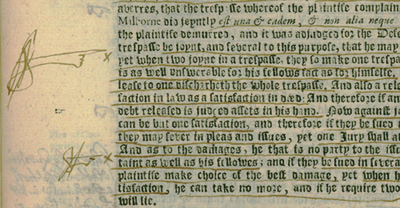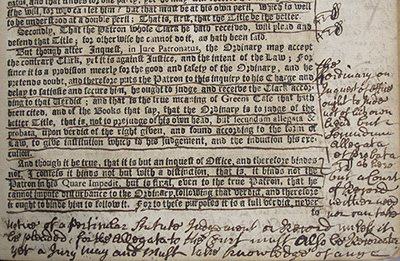
Two of the 352 manicules drawn in a 17th century volume of law reports. Glass Case 346.4 G78kh, Special Collections, University of Auckland Libraries and Learning Services.
Rare books often contain traces of their former owners and signs of reading, such as bookplates, signatures, inscriptions and annotations. These marks can provide valuable insights into who owned the books, how they changed hands and how the texts were considered and used by readers.
One mark left by earlier generations of readers is the manicule, a drawing of a hand and extended finger pointing at a sentence or paragraph of importance or interest. In common use between the 12th and 18th centuries, the symbol is also known as a pointing hand, fist, mutton fist, index and indicator.1
Publishers later added manicules to the margins of printed books as aids for readers while its digital descendants include symbols in word processing packages and the hand that appears when a mouse pointer hovers over a hyperlink.
The manicules pictured above and below are from a heavily annotated mid-17th century book of law reports held in Special Collections.2 The 352 manicules (yes, I counted) range from the functional to the elaborate, complete with cuffs and fingernails. Some of the legal cases seem of particular interest to early readers, and those pages are crammed with marginal notes, underlining and other symbols.

The volume is also heavily annotated in places. Glass Case 346.4 G78kh, Special Collections, University of Auckland Libraries and Learning Services.
One of those readers would have been the `Geo. Bowler’ who wrote his name on the title page in a hand that matches some of the annotations. Some two centuries later, the volume arrived in New Zealand and was kept for a time on the shelves of the `Devonport Public Library Reference Branch’, based on the yellow label pasted to its front pastedown.
Jo Birks, Special Collections
References
1 Sherman, W.H. (2005). Toward a history of the manicule. In Myers, R., Harris, M., & Mandelbrote, G. (Eds.), Owners, annotators, and the signs of reading. New Castle, Del. : Oak Knoll.
2 Great Britain. Court of King’s Bench & Hobart, Sir H. (1658). The reports of that reverend and learned judge, the Right Honourable Sr Henry Hobart knight and baronet, lord chief justice of His Majesties Court of common pleas. London : Leybourn. Glass Case 346.4 G78kh
Note: This is an edited version of a post of 5 August 2010 from the now-retired Special Collections blog.
